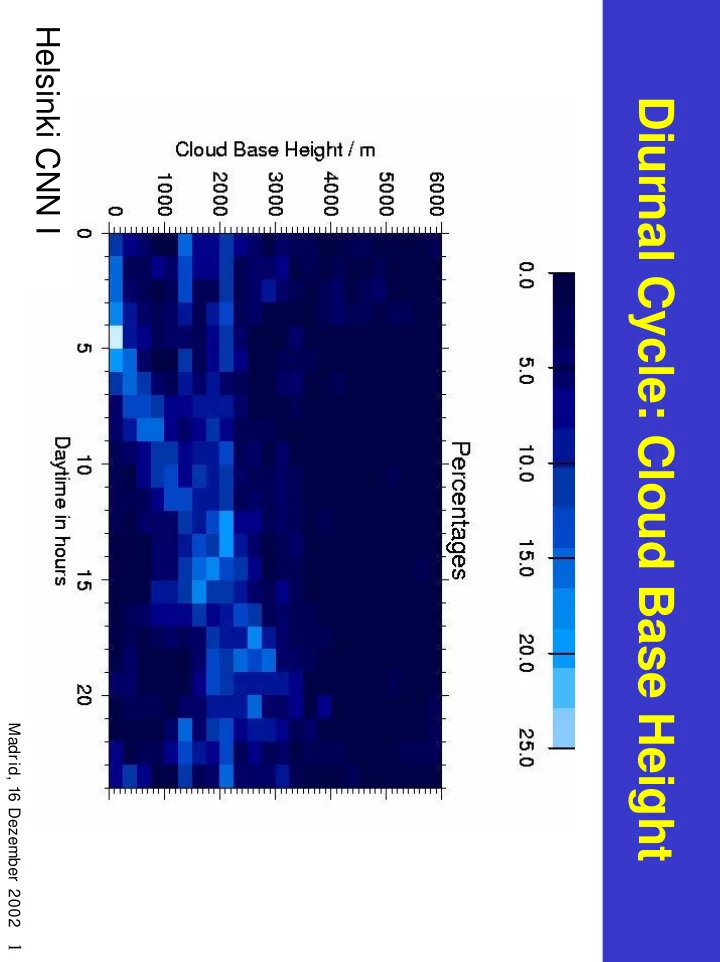

Helsinki CNN I Diurnal Cycle: Cloud Base Height clear sky Madr id, 16 Dezember 2002 1
Cabauw Geesthacht Cabauw Geesthacht Helsinki Kiruna Helsinki Kiruna Lindenberg Onsala Lindenberg Onsala Petersburg Potsdam Petersburg Potsdam CNN I CNN II Madr id, 16 Dezember 2002 2
Diurnal Cycle: Infrared Temperature Lindenberg CNN II clear sky low clouds Madr id, 16 Dezember 2002 3
Bern Cabauw Bern Cabauw Chilbolton Chilbolton Geesthacht Helsinki Helsinki Kiruna Kiruna Lindenberg Lindenberg Onsala Onsala Paris Paris Petersburg Petersburg CNN I CNN II Madr id, 16 Dezember 2002 4
Geesthacht Helsinki Geesthacht Helsinki Kiruna Lindenberg Kiruna Lindenberg Onsala Paris Onsala Paris Potsdam Potsdam LWP only g m -2 cloudy scenes CNN I Madr id, 16 Dezember 2002 5
Geesthacht Helsinki bern Cabauw Kiruna Lindenberg Chilbolton Gotland Onsala Paris Kiruna Lindenberg Potsdam Onsala Potsdam LWP both only cloudy CNN I CNN II Madr id, 16 Dezember 2002 6
Geesthacht Helsinki Geesthacht Helsinki Diurnal Cycle: Infrared Temperature 40 30 20 10 0 Kiruna Lindenberg Kiruna Lindenberg Onsala Paris Onsala Paris Potsdam Potsdam IWV only kg m -2 clouds CNN I Madr id, 16 Dezember 2002 7
Geesthacht Helsinki bern Cabauw Kiruna Lindenberg Chilbolton Gotland Onsala Paris Kiruna Lindenberg Potsdam Onsala Potsdam IWV both only cloudy CNN I CNN II Madr id, 16 Dezember 2002 8
Supercooled Water Layers H.I. Bloemink • Hogan et al. [2002a]: Detection of super-cooled water layers during CLARE from corresponding lidar/radar measurements; mostly embedded in ice clouds; strong impact on radiative budget although little LWP • Hogan et al. [2002b]: climatological analysis of Chilbolton and Cabauw ceilometer measurements; investigation of temperauture influence, layer duration and extent Madr id, 16 Dezember 2002 9
Instrumentation • Vaisala CT75K ceilometer wavelength 905 nm, time resolution: 30 s height resolution: 30 m calibrated backscatter profiles, ⇒ up to three cloud base heights • Radio soundings at De Bilt: Vaisala RS 90 sondes • 22 channel microwave radiometer MICCY ⇒ liquid water path LWP • 3.3 GHz radar TARA time resolution: 10.2 s height resolution: 20 m. • 95 GHz cloud profiling radar MIRACLE time resolution: 5 s height resolution: 82.5 m. Madr id, 16 Dezember 2002 10
Detection of super-cooled layers • A cloud base must be detected (using the algorithm from the ceilometer) • The temperature of the cloud base has to be below 0 °C • The maximum backscatter coefficient b max has to be larger than a threshold (6×10 -5 (sr m) -1 ) • The backscatter coefficient at 300 m above the altitude where the maximum backscatter has been detected should be at least 20 times weaker than b max Madr id, 16 Dezember 2002 11
Statistics during CLIWA-NET a) b) c) d) e) f) Period Base/time <0 °C/time SCL/time <0 °C/base SCL/base SCL/<0 °C (%) (%) (%) (%) (%) (%) CNN I 52 10 (2) 9 (2) 20 (4) 16 (3) 83 (2) CNN II 49 23 (3) 21 (3) 48 (6) 43 (6) 90 (2) BBC* 56 14 (2) 12 (2) 26 (5) 21 (4) 83 (2) Percentage of occurrence of: a) cloud bases detected, b) cloud bases below 0 ºC detected, c) Super-Cooled Layers (SCLs) detected, d) cloud bases below 0 ºC if a cloud base is detected, e) SCLs if a cloud base is detected and f) SCLs if a cloud base below 0 ºC is detected. Uncertainty introduced by a 1K error in temperature is given in brackets. * Measurements at 90 deg Madr id, 16 Dezember 2002 12
LWP Distribution Liquid Water Path distribution for the super-cooled layers detected during CNN II (N=17830) and BBC (N=10963). Time resolution is 30 s. 3 LWP τ = LWP = 25 g m -2 r eff =10 µm ⇒ τ = 4 ρ 2 w r eff Madr id, 16 Dezember 2002 13
LWP Distribution II Function of temperature. The y-axis indicates the number of measurements having the LWP value indicated on the x-axis (with a 1 g/m -2 resolution). Madr id, 16 Dezember 2002 14
Case study 13 April 2002 I Ceilometer backscatter profile (colours) and radiosonde temperatures (white contours) for 13 April 2001 at Cabauw, The Netherlands. Wind from the North at 11 m/s. Madr id, 16 Dezember 2002 15
Case study 13 April 2002 II a) b) c) a) backscatter profile for the 3 GHz radar TARA (colours) and cloud base altitude from the CT75K ceilometer. b) cloud base temperature of the super-cooled water layer (RS) c) liquid water path from the microwave radiometer MICCY. Madr id, 16 Dezember 2002 16
Case study 13 April 2002 III Radio soundings on 13/04/01 from De Bilt (23 km NE from Cabauw). Shown are temperature (solid line) and dewpoint temperature (dashed line) for 6 and 12 UTC. Non continuous layers (celluar structure also on satellite images) Madr id, 16 Dezember 2002 17
Case study 13 April 2002 III Cloud base temperature vs Liquid Water Path for 12 hours of the super-cooled layer observed on 13 April 2001. Correlation between LWP and ceilometer (0.85, 0.63, 0.82 and 0.57 ) is stronger than the one between LWP and infrared radiometer Madr id, 16 Dezember 2002 18
Case study 24 September 2002 I Ceilometer backscatter profile (colours) and radiosonde temperatures (white contours) for 24 September 2001. The wind is easterly (110 ° ) at about 5.5 m/s at cloud height. Madr id, 16 Dezember 2002 19
Case study 24 September 2002 II LWP/Temperature Liquid Water Path from the radiometer MICCY for 24 September 2001. Cloud base temperature of the super-cooled water layer. Madr id, 16 Dezember 2002 20
Lidar / Radar Retrieval Madr id, 16 Dezember 2002 21
Conclusions • Super-cooled water occurs quite frequently at mid- latitudes • LWP of these clouds is quite variable • Super-cooled clouds case study 13 April 2001 ⇒ important for aircraft icing • Super-cooled layers case study 14 September 2001 ⇒ important in radiative aspects Madr id, 16 Dezember 2002 22
Recommend
More recommend